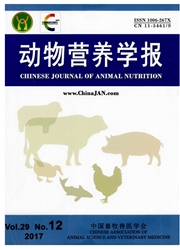

 中文摘要:
中文摘要:
本试验通过组织学染色及16S rRNA V3~V4区测序研究豆油部分或全部替代饲料中鱼油对中华条颈龟(Mauremys sinensis)肠道形态及菌群结构的影响。选取中华条颈龟雌龟[4龄,平均体重(1 557±307)g]24只,随机分为4组,每组6只。Ⅰ组(对照组)饲喂含1%鱼油的配合饲料(全鱼油饲料,豆油与鱼油的比例为0∶3),3个试验组分别饲喂用豆油替代全鱼油饲料中33%(Ⅱ组,豆油与鱼油的比例为1∶2)、67%(Ⅲ组,豆油与鱼油的比例为2∶1)和100%(Ⅳ组,豆油与鱼油的比例为3∶0)鱼油的饲料。每周喂食2次,试验期为10个月。结果表明:1)Ⅰ和Ⅲ组十二指肠绒毛长/隐窝深度(VH/CD)显著高于Ⅱ和Ⅳ组(P〈0.05)。2)根据序列相似性97%水平划分,Ⅰ、Ⅱ、Ⅲ和Ⅳ组操作分类单元(OTU)总数分别为396、321、347和331个,特有OTU个数分别为43、3、4和5个,分别被鉴定出139、117、128、120个属。十二肠道优势菌门主要包含拟杆菌门(Bacteroidetes)、厚壁杆菌门(Firmicutes)、梭杆菌门(Fusobacteria)和变形菌门(Proteobacteria)4个门。Ⅱ、Ⅲ和Ⅳ组梭杆菌门和变形菌门所占比例增加,拟杆菌门和厚壁菌门所占比例下降,Ⅲ组厚壁杆菌门和拟杆菌门所占比例与Ⅰ组差距最小。细菌Ace指数和香农指数表现为Ⅰ组最高,其次是Ⅲ和Ⅳ组,Ⅱ组最小;细菌辛普森指数表现为Ⅱ组最大,其次是Ⅲ和Ⅳ组,Ⅰ组最小。由此得出,饲喂用豆油替代67%鱼油的饲料的中华条颈龟的肠道细胞发育成熟度以及菌群结构与饲喂全鱼油饲料的中华条颈龟相近。
 英文摘要:
英文摘要:
This study was conducted to investigate the effects of partial or total replacement of fish oil by soybean oil on intestinal morphology and microbiota structure of Chinese striped-neck turtle (Mauremys sinensis) by histological staining and 16S rRNA V3-V4 region sequencing. Twenty 4-year adult female Chinese striped- neck turtles [ 4-year-old and the initial body weight of (1 557±307) g] were randomly divided into 4 groups and each group had 6 turtles. Turtles in group I ( control group) were fed a formula feed containing 1% fish oil which was a whole fish oil diet with the ratio of soybean oil to fish oil was 0:3, and others in three experimental groups were fed diets used soybean oil to replace 33% ( group Ⅱ ) , 67% ( group Ⅲ) and 100% ( group Ⅳ) fish oil based on the whole fish oil diet and the ratios of soybean oil to fish oil of them were 1:2, 2:1 and 3:0, respectively. Turtles were fed 2 times per week, and the experiment lasted for 10 months. The results showed as follows : 1) the ratio of villus height to crypt depth (VH/CD) of duodenum in groups Ⅰ and Ⅲ was significantly higher than that in groups Ⅱ and Ⅳ (P〈0.05). 2) According to the 97% level of sequence similarity, the total numbers of operational taxonomic unit (OTU) in groups Ⅰ, 1I, Ⅲ and Ⅳ were 396, 321, 347 and 331, while the specific OTU numbers were 43, 3, 4 and 5, and 139, 117, 128, 120 genus were identified, respectively. The dominant phyla in the duodenum were Bacteroidetes, Firmicutes, Fusobacteria and Proteobacteria. The proportions of Fusobacteria and Proteobacteriai were increased while the proportions of Bacteroidetes and Firmicutes were decreased in groups Ⅱ, m and Ⅳ. However, the small gap of Firmicutes and Bacteroidetes between groups Ⅰ and m. The bacterial Ace index and Shanno index were the highest in group Ⅰ, the middle in groups m and Ⅳ, and the lowest in group Ⅱ. The bacterial Simpson index was the highest in group Ⅱ, the middle in groups Ⅲ a
 同期刊论文项目
同期刊论文项目
 同项目期刊论文
同项目期刊论文
 期刊信息
期刊信息
